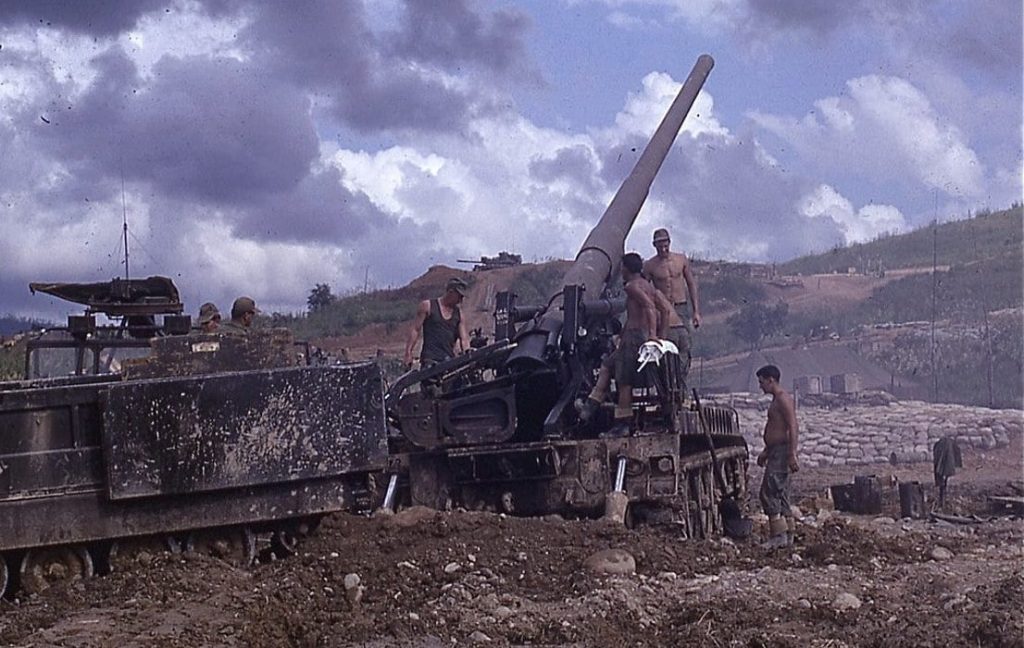
My own stark and dramatic introduction to the overwhelming rat infestation on Vietnam’s firebases occurred, somewhat ironically, during the Chinese “Year of the Rat” – 1972. In January 1972 I took command of C Battery, 3rd Battalion, 82nd Field Artillery Battalion (105mm M102 howitzers) on Fire Support Base (FSB) Maude, aka Hill 350, about 15 kilometers due west of Danang, Vietnam, providing fire support to the 196th Light Infantry Brigade – eventually the 196th became the last ground combat brigade to leave Vietnam (August 1972). From the top of FSB Maude, towering over 1,000 feet above the surrounding pool table flat terrain that was, essentially, at near sea level, we could on a clear day easily see the South China Sea and all of the environs of South Vietnam’s second-largest city. During the monsoon season, when the weather socked-in that region, FSB Maude usually loomed above the billowy, white layer of clouds stretching endlessly in every direction. It gave the appearance that one could almost “walk” on top of those clouds all the way to Danang.
Yet, typical of all of the long-existing American artillery fire bases in I Corps area of South Vietnam, FSB Maude dated back nearly 7 years to its creation shortly after the first U.S. combat troops arrived in Vietnam (the U.S. Marine Corps units that came ashore in Danang in March 1965). To protect the American enclave at Danang, fire bases consisting of, typically, an artillery battery and an infantry battalion headquarters plus one infantry company and a weapons platoon (81-mm mortars) for base security were created in a wide arc west of the enclave. In January 1972, FSB Maude was a fortified, entrenched, barbed wire-enclosed, hilltop firebase, about two-thirds of which was occupied by a 196th Light Infantry Brigade infantry battalion headquarters and infantry company (the battalions “rotated” among the Danang area firebases every few months, so FSB Maude during my tour hosted 2-1st Infantry, 3-21st Infantry, 4-31st Infantry, and 1st-46th Infantry during this timeframe) while the eastern one-third, separated from the “infantry side” of the firebase by a wide helicopter landing pad (our one and only contact with the “outside world”), contained my Charlie Battery, 3-82nd FA. Charlie Battery consisted of 4 officers – “BC” Battery Commander, “XO” Battery Executive Officer and two “FDOs” Fire Direction Officers — plus about 80 cannoneers under our battery senior enlisted soldier, Sergeant First Class “Smoke” Schimmel, the “Chief of Firing Battery” aka “Chief of Smoke”, and one of the finest soldiers with whom I ever served in my 36 years in the Army, while the remainder of the battery’s 20 or so cannoneers were stationed in the battery rear area at the battalion’s Camp Redhorse HQ back in Danang under our battery First Sergeant, 1SG Wirts.
Living conditions on FSB Maude were, understandably, “primitive” (although a significant “step up” from being out in the field in the “boonies”!) with everyone occupying hand-constructed “hootches” carved into the top and sides of Hill 350 and consisting of multiple steel culvert halves and dirt-filled, wooden 105mm ammo boxes, covered by several sturdy layers of sandbags. Only our battery Fire Direction Center and our field kitchen “mess hall” – the highest and most vulnerable structure on FSB Maude– consisted of anything resembling a “fixed structure,” and these were only sand-bagged “conex” containers (cube-shaped – 8X6X6 feet — steel, shipping containers converted to a specific combat purpose). Our 105mm howitzers were in open “firing pits” surrounded by a circular, 4-foot high “berm” created of several layers of sandbags, each gun-pit also contained extra-reinforced, sandbagged ammunition bunkers for easy access to immediately-accessible 105mm projectiles and their fuzes. Yet, we did enjoy at least one “creature comfort” – a telephone booth-sized “hot shower” constructed out of the remains of a canvas tent stretched over a wooden frame, topped by a 55-gallon drum filled with water which was heated by a standard, multi-fuel-burning, G.I. immersion heater. Compared to the infantry “grunts” slogging through the surrounding jungle that we daily supported with artillery firepower, us “Redlegs” on FSB Maude had “all the comforts of home”…well, relatively speaking.
Each day, after I attended the obligatory daily morning briefing of the infantry battalion commander by his staff in the “Grunt TOC” on the other end of the firebase, our days were typically spent enduring a mind-numbing, monotonous and seemingly endless repetition of what G.I.s referred to as “same-o, same-o” – long hours of seemingly interminable boredom punctuated intermittently by periods of frantic activity responding to the calls for “contact” fire missions supporting the infantry companies conducting the battalion’s continuous operations in our area of responsibility. But, our nights…well, our nights were mostly spent repelling the constant assaults of those hordes of voracious rats that erupted, soon after the sun set, out of the vast, years-accumulated heaps of trash and garbage surrounding FSB Maude.
When I first arrived in Vietnam at the huge U.S. base at Cam Ranh Bay on Thanksgiving Day 1971 (I had departed the U.S. on my son’s first birthday, November 24, so our family “celebrated” it a few days before I departed for McChord AFB at Ft. Lewis, WA) after flying into Vietnam on a trans-Pacific World Airways contract flight which included numerous members of my Class of 1969 West Point classmates, I never dreamed I’d have the privilege of commanding a U.S. artillery battery in combat in the rapidly-drawing down Vietnam War – President Richard M. Nixon’s “Vietnamization” of the war was in full swing by then, and at that time only two ground combat brigades remained “in-country” (3d Brigade, 1st Cavalry Division in III Corps area and the 196th Light Infantry Brigade, the successor and remaining infantry brigade of the former Americal Division, in I Corps). But, fortuitously, I was soon sent on to the 196th, and upon arriving in Danang, had a personal interview with the 3-82nd battalion commander, Maj. James K. Broadus – one of the finest officers every produced by the U.S. field artillery. Maj. Broadus asked, “OK, Captain, what would you like to do?” I immediately answered, “Sir, I want to command an artillery battery as soon as possible!” At that time, 3-82nd FA comprised three M102 105mm howitzer batteries (A, B, & C), one battery of M114 155mm towed howitzers, and an attached, combined 8-inch/175mm battery on loan from XXIVth Corps Artillery. Thankfully, Maj. Broadus quickly agreed.
Luckily, before assuming battery command as a brand-new Captain (only two-and-a-half years after U.S. Army commissioning), I was able to get my feet on the ground and acclimate myself to Vietnam by serving as battalion Assistant S-3 Operations Officer, during which I learned much about serving in Vietnam. My only regret during that apprenticeship was having to preside over a brigade “combat insertion” on Christmas Day 1971, causing me to miss Bob Hope’s USO Tour visit to Danang.
In January 1972 I took command of Charlie Battery from its previous commander, Captain Jim DeLoach.
It was a dream come true – except for the nighttime “nightmare” rats! During my first night as Charlie Battery commander, I awoke on my cot in my sandbagged hootch on FSB Maude from an unusually vivid dream about a cat sitting on my chest, tickling my face and neck with its whiskers. But, upon awakening, I found myself staring directly into the beady red eyes of a huge rat sitting on my chest! I reflexively struck out, knocking the creature off my chest, but that only seemed to “annoy” it. Hitting the floor, the rat quickly recovered and, it appeared in my not-quite-fully-awake state, was preparing a counterattack! Fumbling in the dark in still unfamiliar surroundings, I grabbed my M1911A1 .45 pistol from under my pillow, jerked back and released the slide, chambering a round, pointed it toward the “monster” rat and…luckily woke up enough to realize what was happening – and what could happen! – I judiciously flicked on the thumb safety.
Had I actually fired at the rat, I could have endangered my innocently sleeping “hootch-mate,” our battery XO, Lt. Williams, and most likely deafened both of us in the process. For the full effect had I fired, try enclosing yourself in something like my sandbagged “hootch” – a claustrophobic, eight foot-by-four foot-by-five foot “tunnel,” barely sufficient to contain a standard military cot, and certainly not high enough to permit a normal-sized American to stand upright without stooping – then fire a heavy, 230-grain round from one of the world’s most powerful handguns. If you can envision that, you’ll have some idea of the shot’s potentially deafening explosion. My “lesson learned” that night was that .45-caliber pistols definitely are not “weapons of choice” for eradicating rats.
Through hard-earned experience, we developed a number of “anti-rat” weapons, usually unsuccessfully employed. Chief among these were traps – but not standard, large “rat traps” encountered stateside. We did requisition and receive the standard large rat traps, but these proved totally ineffective – although the rats would “trigger” the traps and get caught by them, the persistent rodents would simply shrug them off and just carry the traps with them as they scurried back to their trash dump sanctuaries.
Next, we tried “building a better mouse trap” (“rat trap” in this case). We cut a one foot by one foot section of plywood, nail four large rat traps – each facing in-wards – to each corner, then anchor this “four-plex” rat trap firmly in place with a length of sturdy commo wire attached to an immoveable object. It was a brilliant idea! It seemed the solution to our “rat problem,” and…it didn’t work. When caught in the traps, the rats simply chewed through the commo wire like soft butter and fled back into their “trash heap” sanctuaries to stage for another nightly assault.
We eventually discovered through trial and error that one of the most effective means of killing the large rodents was to shoot them individually with “soap bullets” – M16 rounds in which the full metal jacket projectiles were removed and replaced by inserting the “business end” of the round into a bar of soap, thereby “arming” the bullets with a solid block of wax-like soap. Propelled by the bullets’ powder charge, the “soap bullets” could easily kill a rat without endangering any nearby G.I.s. But that method’s significant danger arose when soldiers inevitably lost track of their “soap bullets” and inadvertently let loose with a “real” bullet – “pop,” “pop,” “pop,” “BLAM!!” the latter ricochet in the close quarters of a G.I. “hootch” causing everyone to duck for cover! Obviously, this was too dangerous as the “rat problem” solution.
A fortuitous accident in late-February 1972 actually revealed a better “rat problem” solution. During a routine helicopter lift of our battery “water buffalo,” the G.I. nickname for the two-wheeled, 845-gallon capacity G527 water carrier, static electricity from the CH-47 helicopter accidentally set off one of the “Fougasse” explosives planted all around our firebase for close-in defense against possible enemy ground attacks. This slurry of diesel and gasoline in a 55-gallon drum wrapped in detonating-cord and primed with C-4 explosive to be electronically triggered, if necessary, exploded that day in a massive blast of flame and oily smoke towering over our firebase (nearly engulfing our “mess hall” conex!). Thousands upon thousands of rats were instantly incinerated and additional thousands more fled from the trash heap into the jungle to escape the inferno. Great! Burn you little bastards!
In a final irony that even Hollywood would hesitate to portray, one of the last movies we played on FSB Maude was…you guessed it!…Willard! No kidding!! Naturally, the G.I.s enthusiastically cheered for the rats – some, tongue-in-check, quipped, “Hey, BC, this must have been filmed on Maude, right?”!
For our remaining time on FSB Maude, rats continued to annoy us; but, periodically we applied the proven “Fougasse” treatment, incinerating the rotting trash dumps. Yet, when the last U.S. ground troops evacuated the Danang area in August 1972, even a “math goat,” like me could confidently predict that our persistent, prolific “rat enemies” will have eventually prevailed, long ago reoccupying our abandoned positions. Much like our VC and NVA enemies, all our rodent nemesis need do to ultimately prevail was simply to outlast us…
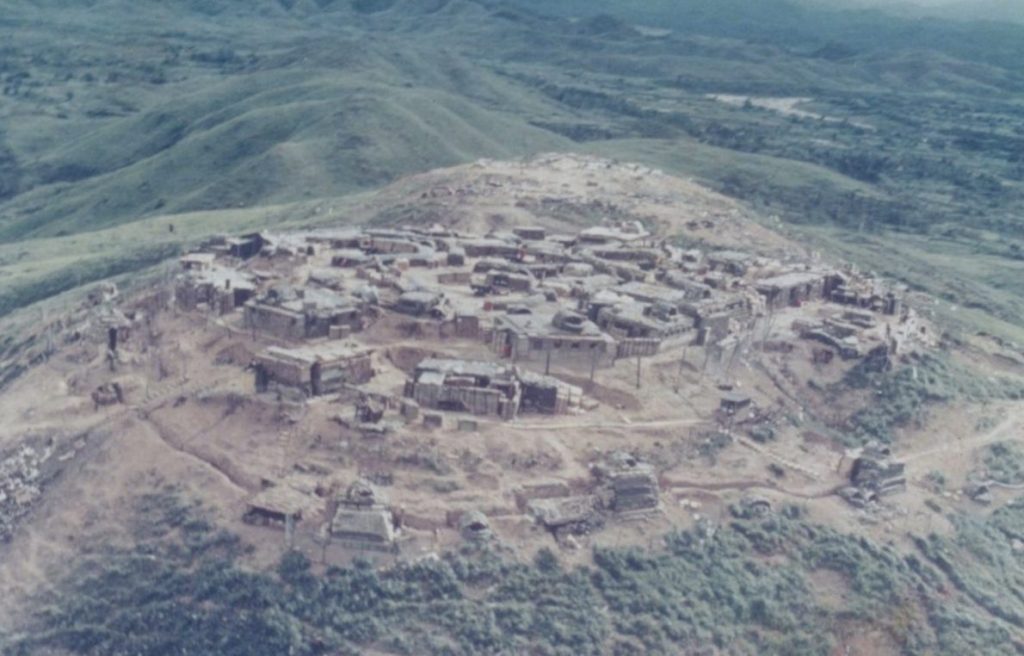
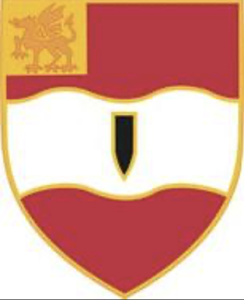
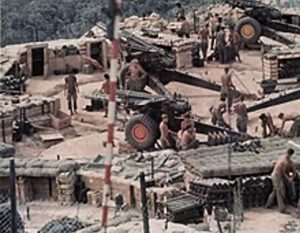
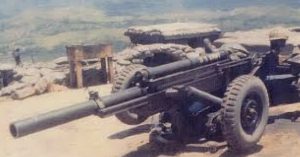
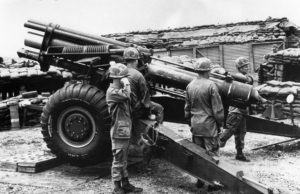
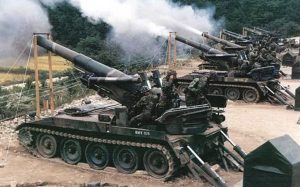

Dear Jerry:
Thanks for following on from Part 1 with another great story in Part 2.!
Not that breeding a cat population to handle the rats, as I inquired about earlier, would be workable, but here’s a possible solution that would kill two or more “birds” (any problem with them, too?) at the same time? You said the FB suffered from “same-o, same-o” monotony. Also, I just recently learned/appreciated that the relative “safety” of FBs was due to the fact that FBs supported one another with pre-registered, precision fire. How about just asking a nearby firebase to occasionally lay down a barrage just outside your wire? Surely, I jest, gets rid of the rats, keeps the VC away, and livens things up a bit (no mo “same-o-same o”)? 🙂
BTW, you’re looking great and ready for any clash there with that handsome mustache (ready to join Harrison Ford’s Lost-Ark-Raiders team at a moment’s notice)! 🙂
Seriously, though, thanks again for a great two-part story!
Best regards & BOTL,
Bill
Jerry, great pair of stories – especially the intro of part one. As I first read it I’m thinking “this guy is in deep Sherlock” until you mentioned they were rats. I was an advisor out on a district team living with the Vietnamese, and we had a minor rat problem, although nothing like you described. We had a part time” hooch maid” who was terrified of them; we called her Ba Chuot (Mrs. Rat in Vietnamese). We had one big one, the size of a cat, who lived near our generator bunker, and with whom I had contact at night when I went to shut down the generator. I too was tempted to shoot it, but discharging a weapon inside the compound was not something to be done, especially at night, since it would have triggered an automatic defensive reaction to an enemy attack. Our trash problem was not as bad, since we were near a local road, along which support trucks from PA & E (Pacific Architects and Engineers), our support contractor who provided water, septic and refuse removal capabilities, could move when combat activity was not present. A tour in Vietnam made one appreciate being “back in the world”.
Loved it, Jerry. I bet you have many more good tales to tell.
Cheers,
Pete
Thanks, Jerry, great story. We had rats on our firebases, but not in epic proportions like you! Hope you are doing well …
Thank you for this story about life on Maude, sir.
I used to look at your perimeter lights from across the valley on Linda, in the evening, while on our own perimeter guard watch.
I found your article by searching for references to Camp Redhorse.
I arrived in Da Nang in February, 72 and was sent to 3/82 FA with an ultimate assignment in A Battery on Hill 270 (Linda) as an E-4 13E20 in FDC.
About 2 months later I was sent to BN S-1 to work for CPT Guy V. Nanney as his morning reports clerk.
When the 196th LIB stood down in June, 72, I was chosen to remain as a battery clerk at the airbase HQ of Battery B, in support of 3/21 INF as members of the “Operation Gimlet* residual force.
I returned to VN in 2018 and have been married to a woman from Quảng Ngãi since 2022.
We live in Đà Nẵng now to support her daughters attending a local university.
I hadn’t been too interested in revisiting old AOs, but I recently met a fellow local Veteran who wanted to tell me all he’d learned in his search for Camp Reasoner.
We were very restricted at Camp Redhorse, so I don’t recall if one of my few trips outside the perimeter took me near there so I’m not drawn to visit it.
But I’d be interested in locating the map coordinates for Camp Redhorse, as I’d like to see how that area has developed.
I did find the coordinates for LZ LINDA, starting with AT 865681, then discovering it was located in map sector 49P.
That gave me the MGRS coordinates necessary to locate 15°58’21.0″N 108°04’16.9″E on Google Maps.
I’m hoping you might still have the 8 character map code for Camp Redhorse. If not, I fully understand.
Welcome Home!
I spent over 1 year on fire base 6 as chief of
Firing battery the youngest E-6 at 20 years old. Are fire base was infested with rats
Many times they would get inside my cot.
One night I woke up with a rat chewing on my toe. I had my mosquito net tucked in around me so I had this rat trapped in with
Me and we both were fighting to get out.
I have killed hundreds of rats as my entertainment was killing rats. My funest
Way was to put candy inside a powder
Tube then I would put a blasting cap
In the front of tube. When the rat would go in for the candy I would touch the wires
That went to the blasting cap and the rat would be blown back out of the tube. The
Most effective way I had to kill rats was a
10 foot rubber hose. On a moonlight night
I could easily kill 5 to 10 rats. The rats
Would come to the garbage and I would
Kill them by swing the hose like a whip. Well
There it is rat killer.